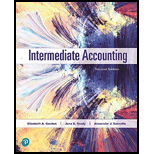
Intermediate Accounting (2nd Edition)
2nd Edition
ISBN: 9780134730370
Author: Elizabeth A. Gordon, Jana S. Raedy, Alexander J. Sannella
Publisher: PEARSON
expand_more
expand_more
format_list_bulleted
Question
Chapter 14, Problem 14.17E
To determine
To prepare: The
Expert Solution & Answer
Want to see the full answer?
Check out a sample textbook solution
Students have asked these similar questions
Solve this financial Accounting problem
Please provide the accurate solution to this financial accounting question using valid calculations.
Please provide the accurate answer to this financial accounting problem using valid techniques
Chapter 14 Solutions
Intermediate Accounting (2nd Edition)
Ch. 14 - What conditions or terms does a note payable...Ch. 14 - If the market rate of interest exceeds the face or...Ch. 14 - What is included in bond issue costs and how...Ch. 14 - Prob. 14.4QCh. 14 - When a bond is issued at a discount, will its...Ch. 14 - Prob. 14.6QCh. 14 - Prob. 14.7QCh. 14 - Under IFRS, how do firms account for convertible...Ch. 14 - Prob. 14.9QCh. 14 - Can companies reclassify short-term debt expected...
Ch. 14 - Under IFRS, can companies reclassify short-term...Ch. 14 - Do companies always reclassify long-term debt that...Ch. 14 - Prob. 14.13QCh. 14 - Prob. 14.14QCh. 14 - Prob. 14.15QCh. 14 - Prob. 14.16QCh. 14 - Prob. 14.1MCCh. 14 - Prob. 14.2MCCh. 14 - Prob. 14.3MCCh. 14 - Prob. 14.4MCCh. 14 - Prob. 14.5MCCh. 14 - Clothes Horse Corp. (CHC) Issued 500,000 bonds due...Ch. 14 - Prob. 14.7MCCh. 14 - Prob. 14.8MCCh. 14 - Prob. 14.9MCCh. 14 - Prob. 14.10MCCh. 14 - Prob. 14.11MCCh. 14 - Prob. 14.1BECh. 14 - Notes Payable. Using the information provided in...Ch. 14 - Prob. 14.3BECh. 14 - Prob. 14.4BECh. 14 - Prob. 14.5BECh. 14 - Prob. 14.6BECh. 14 - Bond Terminology. Match each term with its...Ch. 14 - Bond Pricing. Fill in the missing items for each...Ch. 14 - Prob. 14.9BECh. 14 - Bond Issue Price. Using the information from...Ch. 14 - Prob. 14.11BECh. 14 - Prob. 14.12BECh. 14 - Prob. 14.13BECh. 14 - Prob. 14.14BECh. 14 - Prob. 14.15BECh. 14 - Prob. 14.16BECh. 14 - Prob. 14.17BECh. 14 - Prob. 14.18BECh. 14 - Bonds Issued between Interest Payment Dates. For...Ch. 14 - Prob. 14.20BECh. 14 - Prob. 14.21BECh. 14 - Prob. 14.22BECh. 14 - Prob. 14.23BECh. 14 - Prob. 14.24BECh. 14 - Prob. 14.25BECh. 14 - Prob. 14.26BECh. 14 - Prob. 14.27BECh. 14 - Prob. 14.28BECh. 14 - Prob. 14.29BECh. 14 - Prob. 14.30BECh. 14 - Short-Term Debt Expected to Be Refinanced, IFRS....Ch. 14 - Prob. 14.32BECh. 14 - Prob. 14.33BECh. 14 - Prob. 14.34BECh. 14 - Prob. 14.35BECh. 14 - Fair Value Option. Saratoga Company issued bonds...Ch. 14 - Prob. 14.37BECh. 14 - Financial Statement Disclosure. Use the following...Ch. 14 - Prob. 14.1ECh. 14 - Prob. 14.2ECh. 14 - Prob. 14.3ECh. 14 - Prob. 14.4ECh. 14 - Prob. 14.5ECh. 14 - Bond Issue, Interest Payments, Effective Interest...Ch. 14 - Prob. 14.7ECh. 14 - Prob. 14.8ECh. 14 - Prob. 14.9ECh. 14 - Prob. 14.10ECh. 14 - Prob. 14.11ECh. 14 - Prob. 14.12ECh. 14 - Convertible Bonds, Conversion. On January 1, 2018,...Ch. 14 - Convertible Bonds, Conversion. Using the...Ch. 14 - Prob. 14.15ECh. 14 - Prob. 14.16ECh. 14 - Prob. 14.17ECh. 14 - Prob. 14.18ECh. 14 - Warrants. DHC Associates issued 2,100 of its...Ch. 14 - Prob. 14.20ECh. 14 - Prob. 14.21ECh. 14 - Prob. 14.1PCh. 14 - Long-Term Notes Payable, Semiannual Interest,...Ch. 14 - Note Payable Issued at a Discount with...Ch. 14 - Prob. 14.4PCh. 14 - Prob. 14.5PCh. 14 - Bond Issue, Interest Payments, Effective Interest...Ch. 14 - Prob. 14.7PCh. 14 - Bonds Sold between Interest Dates at a Discount,...Ch. 14 - Prob. 14.9PCh. 14 - Prob. 14.10PCh. 14 - Convertible Bonds, Bond Issue Costs, Conversion....Ch. 14 - Prob. 14.12PCh. 14 - Prob. 14.13PCh. 14 - Prob. 1JCCh. 14 - Prob. 2JCCh. 14 - Prob. 3JCCh. 14 - Prob. 1FSCCh. 14 - Prob. 1SSCCh. 14 - Surfing the Standards Case 2: Bonds with...Ch. 14 - Prob. 1BCC
Knowledge Booster
Similar questions
- What was the net income?arrow_forwardAbigail, a manufacturer of audio equipment for home theatres, has current sales of $72 million and variable operating costs of $50.4 million. Abigail expects to increase sales in the coming year by 15% while keeping fixed operating costs constant at $14.8 million. What is the DOL for Abigail? a. 1.75 . 2.85 c. 3.18 d. 4.25arrow_forwardFixed overhead:55, Variable overhead:25arrow_forward
arrow_back_ios
SEE MORE QUESTIONS
arrow_forward_ios
Recommended textbooks for you
 Excel Applications for Accounting PrinciplesAccountingISBN:9781111581565Author:Gaylord N. SmithPublisher:Cengage Learning
Excel Applications for Accounting PrinciplesAccountingISBN:9781111581565Author:Gaylord N. SmithPublisher:Cengage Learning Intermediate Accounting: Reporting And AnalysisAccountingISBN:9781337788281Author:James M. Wahlen, Jefferson P. Jones, Donald PagachPublisher:Cengage Learning
Intermediate Accounting: Reporting And AnalysisAccountingISBN:9781337788281Author:James M. Wahlen, Jefferson P. Jones, Donald PagachPublisher:Cengage Learning Cornerstones of Financial AccountingAccountingISBN:9781337690881Author:Jay Rich, Jeff JonesPublisher:Cengage Learning
Cornerstones of Financial AccountingAccountingISBN:9781337690881Author:Jay Rich, Jeff JonesPublisher:Cengage Learning

Excel Applications for Accounting Principles
Accounting
ISBN:9781111581565
Author:Gaylord N. Smith
Publisher:Cengage Learning

Intermediate Accounting: Reporting And Analysis
Accounting
ISBN:9781337788281
Author:James M. Wahlen, Jefferson P. Jones, Donald Pagach
Publisher:Cengage Learning

Cornerstones of Financial Accounting
Accounting
ISBN:9781337690881
Author:Jay Rich, Jeff Jones
Publisher:Cengage Learning